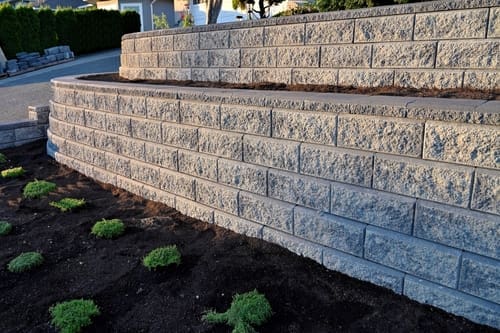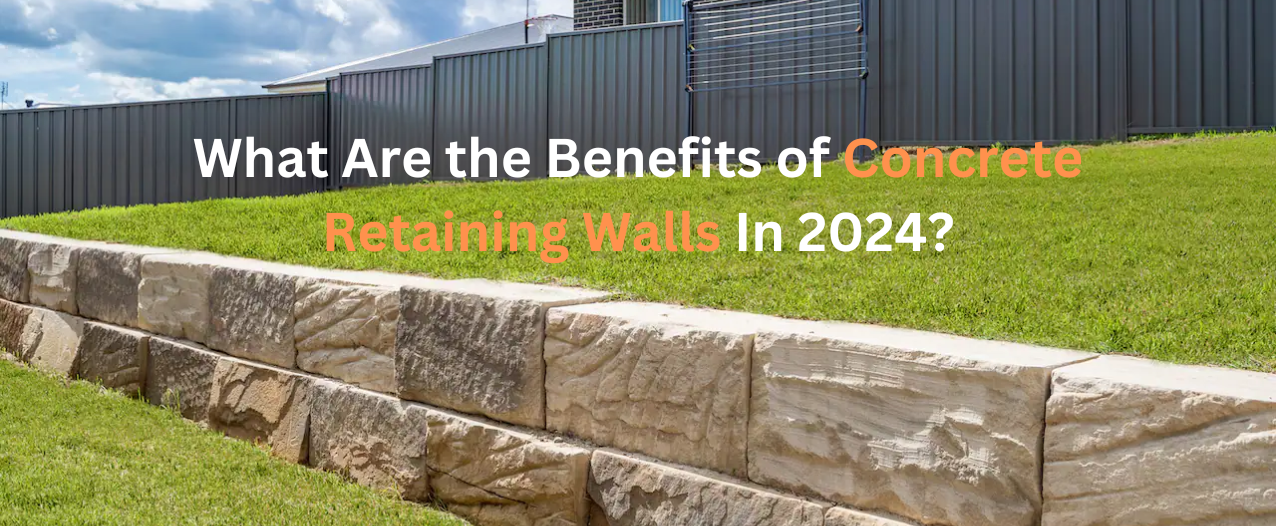Secret Considerations for Structure Effective Retaining Walls in Your Yard
When you're thinking about developing a retaining wall in your lawn, it's crucial to think regarding several key factors. The wall's purpose, the materials you'll use, and the certain soil conditions can all impact its performance and long life.
Understanding the Function of Your Retaining Wall
When you believe regarding building a preserving wall surface, consider its main function: maintaining soil and avoiding erosion. Retaining walls supply necessary support for sloped landscapes, assisting to maintain dirt integrity. You'll find they're important in areas where water runoff could otherwise get rid of dirt, bring about expensive fixings and landscape damages.
By keeping back earth, these walls create degree surface areas for yards, patios, or pathways. This not only boosts your backyard's looks but additionally advertises much better drainage, decreasing water merging in unwanted areas. If you're dealing with high slopes, a sound retaining wall can protect against landslides, making sure safety for you and your building.
Eventually, recognizing the purpose of your retaining wall will certainly assist your style decisions and aid you develop a useful, resilient structure that satisfies your demands. So, take a minute to examine your landscape; it'll settle in the long run.
Picking the Right Materials
When selecting materials for your retaining wall, you'll wish to think about sturdiness, looks, and cost. Each variable plays a vital function in guaranteeing your wall stands the examination of time while looking fantastic and fitting your budget plan. Allow's discover exactly how to make the very best choices for your job.
Product Longevity Elements
Selecting the appropriate materials is important for the longevity and effectiveness of your retaining wall surface, since their resilience directly affects the wall's capacity to hold up against ecological anxieties. Start by considering your regional environment; materials like concrete and rock resist wetness and temperature level variations well. If you live in an area susceptible to heavy rains, choose materials with excellent water drainage properties, like gravel or porous blocks, to stop water build-up.
In addition, think of the soil conditions on your residential or commercial property. Some products execute much better in certain dirt kinds, so it is necessary to match them appropriately. Ultimately, be mindful of prospective wear from parasites or disintegration. Choosing sturdy materials assurances your retaining wall surface stands solid, safeguarding your yard for many years ahead.
Visual Style Options
Durable materials not just ensure your retaining wall's structural stability however likewise play a key role in its aesthetic charm. When choosing the appropriate materials, consider just how they match your landscape. All-natural rock uses a classic, rustic appearance, while concrete blocks can offer a sleek, modern-day surface. You may additionally think about making use of hardwood for a warm, natural feeling. Color and structure matter, also; select tones that harmonize with your home and yard. Do not neglect concerning the wall's form-- rounded walls can produce a softer appearance, while straight lines can feel extra organized. By carefully picking materials that align with your visual vision, you'll enhance your exterior area while guaranteeing your wall surface stands strong against the components.
Cost-Effectiveness Evaluation
Choosing the best products for your retaining wall surface isn't just about visual appeals; it's also essential for your budget plan. When choosing materials, take into consideration both upfront prices and long-term durability. Concrete blocks may be costlier originally, yet their long life can save you cash on repair work. On the other hand, hardwood can be more budget friendly but might need replacement faster.
Do not neglect to element in upkeep prices. Some products, like natural rock, can add elegance and require less maintenance, while others might require routine treatments
Inevitably, weigh the advantages and disadvantages of each option against your budget and the wall's designated purpose. Investing wisely in materials currently can protect against costly concerns down the road. Pick products that balance cost and performance properly.
Assessing Dirt Conditions and Drain
As you start your task, assessing dirt conditions and drainage is essential for the success of your retaining wall. Begin by analyzing the kind of soil in your backyard. Sandy soil drains pipes well yet does not have security, while clay soil can preserve wetness, causing press on your wall. Evaluate the dirt's wetness content by digging a little opening and observing just how swiftly it dries.
Next, assess the incline of your backyard. If water naturally streams towards your wall, you'll require to execute a water drainage solution to avoid disintegration and stress build-up. Think about setting up perforated pipes or gravel backfill behind the wall surface to promote drain.
Last but not least, observe any type of close-by trees or vegetation; their roots can influence dirt stability. By understanding your dirt conditions and carrying out appropriate drain, you'll develop a solid structure for your retaining wall surface that stands the examination of time.
Adhering To Local Building Regulations
Before you begin building your retaining wall surface, you need to study local laws to guarantee compliance. It's vital to recognize what allows you must get, as this can save you from costly fines or needing to redesign your job. Taking these actions seriously will assist you build a safe and reliable framework.
Study Local Laws
Recognizing local laws is essential when preparing your retaining wall surface job, especially given that constructing codes can vary you can try this out greatly by place. Begin by checking with your neighborhood building division or town to discover certain demands. Seek standards on wall surface elevation, materials, drainage systems, and architectural integrity. Many areas have limitations on the sorts of materials you can utilize and exactly how high you can build. You'll additionally wish to consider the zoning regulations that could affect your task. Overlooking these regulations can lead to pricey fines or the need to redesign your job. By doing your research study upfront, you can guarantee your retaining wall satisfies all essential codes and blends effortlessly right into your backyard.
Acquire Required Licenses
When you have actually looked into neighborhood policies, the following action is to acquire the necessary permits for your retaining wall job. They may call for certain plans or engineering assessments, specifically for larger walls. Safeguarding the best approvals can save you from pricey fines or having to dismantle your wall later on.

Planning the Style and Appearance
As you start preparing the design and visual appeals of your retaining wall, consider exactly how it will certainly integrate with the bordering landscape. Consider the materials you'll make use of-- rock, block, or concrete-- and how they'll complement your home's style and the all-natural elements in your backyard. Select shades and textures that mix seamlessly with existing features like outdoor patios, pathways, or gardens.
Following, imagine the wall surface's form and height. Rounded walls can soften a rigid landscape, while straight lines may communicate an extra contemporary look. Do not neglect to integrate plants and plant around the wall surface for an all-natural touch; this can enhance its charm and integrate it right into the setting.
Finally, remember functionality. Your style needs to not just be visually pleasing however additionally offer its objective effectively. By thoughtfully planning these aspects, you'll create a retaining wall that boosts your yard's elegance while meeting its architectural function.
Determining Height and Thickness Needs
To develop a strong retaining wall surface, you require to properly determine its height and thickness needs based on the dirt problems and the elevation of the slope it will certainly support. Beginning by reviewing the incline's angle and the kind of dirt, as different dirts put in varying amounts of pressure.
For walls over 4 feet high, consider a thickness of a minimum of 12 inches. If the wall surface is taller, enhance the density proportionally to maintain stability.
Following, determine the height of the wall surface by measuring the vertical distance it requires to maintain. For every foot of elevation, you must generally prepare for a thickness of one-third of the wall's elevation.
Always bear in mind to represent additional factors like drain and backfill, which can influence your wall surface's style. Proper estimations now assure your retaining wall stands strong and lasts for many years to find.
Upkeep and Durability Considerations
While preserving your retaining wall surface could appear like a reduced concern, overlooking it can bring about substantial issues over time. Regular inspections are important; check for fractures, bulges, or any kind of indications of water damages. Addressing these issues early can conserve you from expensive repairs down the road.
Watch on drain systems, as well. Blocked drains can cause water to develop up, putting in pressure on your wall surface and endangering its stability. Clear debris and assurance appropriate flow to preserve long life.
You may likewise wish to show on sealing Learn More your wall to protect it from dampness and weathering. Depending upon the material, this may require reapplication every few years.
Lastly, landscaping around your wall can support its stability. Stay clear of growing big trees close by, as their origins can threaten the structure. With positive maintenance, your retaining wall surface can offer you well for years ahead.

Often Asked Inquiries
Can I Build a Retaining Wall by Myself, or Should I Hire a Specialist?
You can certainly construct a preserving wall on your own if you have the right devices and expertise. However, working with a specialist guarantees it's done correctly, especially for larger or even more intricate structures. Consider your ability degree before Get More Information determining.
What Are one of the most Typical Mistakes Made When Building Retaining Walls?
When developing retaining walls, you may ignore correct drain, skip using the appropriate products, or neglect reinforcement. These common blunders can bring about architectural failure, so take your time and strategy meticulously to prevent issues.
Exactly how Do I Know if My Retaining Wall Needs Reinforcement?
You'll know your retaining wall surface needs reinforcement if you see fractures, leaning, or protruding. Check for water pooling behind it or dirt erosion near the base. Address these signs promptly to avoid more damages.
What Plants Are Suitable for Landscaping Around a Retaining Wall?
When landscape design around a maintaining wall, think about making use of low-maintenance plants like succulents, ornamental lawns, or creeping ground covers - OKC Precision Retaining Walls. They'll flourish in those conditions and add elegance while avoiding soil disintegration around your wall
Exactly How Can I Avoid Disintegration Around My Retaining Wall?
To stop disintegration around your retaining wall, you can grow ground cover, usage mulch, and install drain systems. Consistently look for water accumulation and readjust landscape design to reroute overflow away from the wall surface.